Language and Executive Functioning: Children’s Benefit from Induced Verbal Strategies in Different Tasks
- Simone Fatzer
- Claudia Roebers
Abstract
The interplay of language and cognition in children’s development has been subject to research for a long time.
The present study followed up on recently reported deleterious effects of articulatory suppression on children’s
executive functioning (Fatzer & Roebers, 2012), aiming to provide more empirical evidence on the differential
influence of language on executive functioning. In the present study, verbal strategies were induced in three
executive functioning tasks. The tasks were linked to the three central executive functioning dimensions of
updating (Complex Span task), shifting (Cognitive Flexibility task) and inhibition (Flanker task). It was expected
that the effects of the verbal strategy instruction would counter the results of articulatory suppression and thus be
strong in the Complex Span task, weak but present in the Cognitive Flexibility task and small or nonexistent in
the Flanker task. N = 117 children participated in the study, with n = 39 four-year-olds, n = 38 six-year-olds, and
n = 40 nine-year-olds. As expected, results revealed a benefit from induced verbal strategies in the Complex
Span and the Cognitive Flexibility task, but not in the Flanker task. The positive effect of strategy instruction
declined with increasing age, pointing to more frequent spontaneous and self-initiated use of verbal strategies
over the course of development. The effect of strategy instruction in the Cognitive Flexibility task was
unexpectedly strong in the light of the only small detrimental effect of articulatory suppression in the preceding
study. Implications for language’s involvement in the different executive functioning dimensions and for practice
are discussed.
- Full Text:
 PDF
PDF
- DOI:10.5539/jedp.v3n1p1
Journal Metrics
(The data was calculated based on Google Scholar Citations)
1. Google-based Impact Factor (2021): 1.11
2. h-index (December 2021): 29
3. i10-index (December 2021): 87
4. h5-index (December 2021): N/A
5. h5-median (December 2021): N/A
Index
- Academic Journals Database
- CNKI Scholar
- Copyright Clearance Center
- CrossRef
- Elektronische Zeitschriftenbibliothek (EZB)
- EuroPub Database
- Excellence in Research for Australia (ERA)
- Harvard Library
- Jisc Library Hub Discover
- JournalSeek
- JournalTOCs
- LIVIVO (ZB MED)
- LOCKSS
- MIAR
- Open Access Journals Search Engine(OAJSE)
- PKP Open Archives Harvester
- Publons
- ROAD
- Scilit
- SHERPA/RoMEO
- Standard Periodical Directory
- Stanford Libraries
- Technische Informationsbibliothek (TIB)
- UCR Library
- UoB Library
- WorldCat
- Zeitschriften Daten Bank (ZDB)
Contact
- Carol WongEditorial Assistant
- jedp@ccsenet.org
